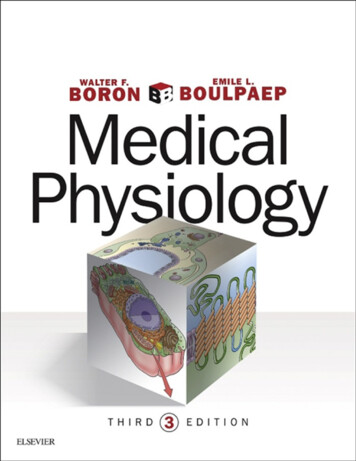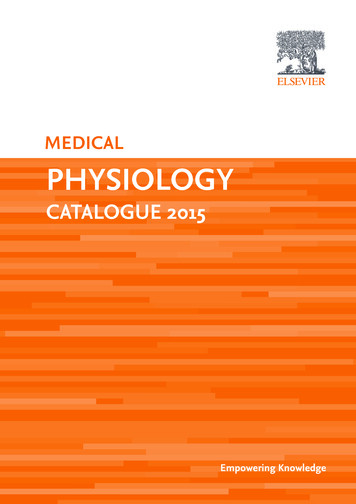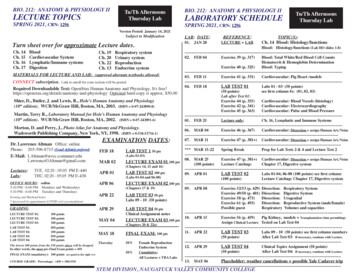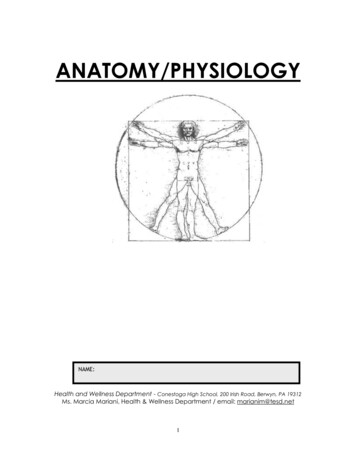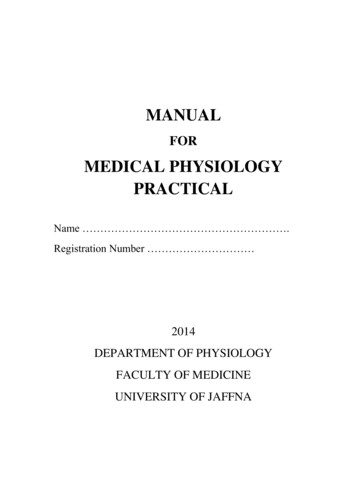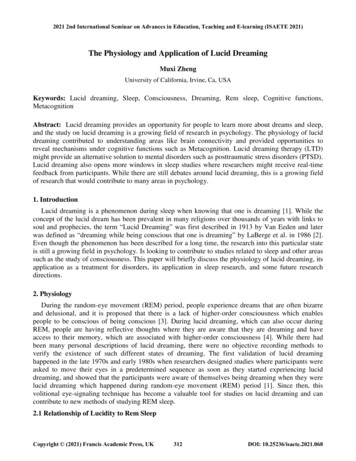
Transcription
2021 2nd International Seminar on Advances in Education, Teaching and E-learning (ISAETE 2021)The Physiology and Application of Lucid DreamingMuxi ZhengUniversity of California, Irvine, Ca, USAKeywords: Lucid dreaming, Sleep, Consciousness, Dreaming, Rem sleep, Cognitive functions,MetacognitionAbstract: Lucid dreaming provides an opportunity for people to learn more about dreams and sleep,and the study on lucid dreaming is a growing field of research in psychology. The physiology of luciddreaming contributed to understanding areas like brain connectivity and provided opportunities toreveal mechanisms under cognitive functions such as Metacognition. Lucid dreaming therapy (LTD)might provide an alternative solution to mental disorders such as posttraumatic stress disorders (PTSD).Lucid dreaming also opens more windows in sleep studies where researchers might receive real-timefeedback from participants. While there are still debates around lucid dreaming, this is a growing fieldof research that would contribute to many areas in psychology.1. IntroductionLucid dreaming is a phenomenon during sleep when knowing that one is dreaming [1]. While theconcept of the lucid dream has been prevalent in many religions over thousands of years with links tosoul and prophecies, the term “Lucid Dreaming” was first described in 1913 by Van Eeden and laterwas defined as “dreaming while being conscious that one is dreaming” by LaBerge et al. in 1986 [2].Even though the phenomenon has been described for a long time, the research into this particular stateis still a growing field in psychology. Is looking to contribute to studies related to sleep and other areassuch as the study of consciousness. This paper will briefly discuss the physiology of lucid dreaming, itsapplication as a treatment for disorders, its application in sleep research, and some future researchdirections.2. PhysiologyDuring the random-eye movement (REM) period, people experience dreams that are often bizarreand delusional, and it is proposed that there is a lack of higher-order consciousness which enablespeople to be conscious of being conscious [3]. During lucid dreaming, which can also occur duringREM, people are having reflective thoughts where they are aware that they are dreaming and haveaccess to their memory, which are associated with higher-order consciousness [4]. While there hadbeen many personal descriptions of lucid dreaming, there were no objective recording methods toverify the existence of such different states of dreaming. The first validation of lucid dreaminghappened in the late 1970s and early 1980s when researchers designed studies where participants wereasked to move their eyes in a predetermined sequence as soon as they started experiencing luciddreaming, and showed that the participants were aware of themselves being dreaming when they werelucid dreaming which happened during random-eye movement (REM) period [1]. Since then, thisvolitional eye-signaling technique has become a valuable tool for studies on lucid dreaming and cancontribute to new methods of studying REM sleep.2.1 Relationship of Lucidity to Rem SleepCopyright (2021) Francis Academic Press, UK312DOI: 10.25236/isaete.2021.068
While lucid dreaming happens during REM, it has been debated whether lucidity is a phenomenonin REM instead of a separate sleep state [5]. The study by Voss et al. measured differences in brainactivity during lucid-REM, non-lucid REM, and wakefulness with EEG [5]. It was shown that duringlucid dreaming, the power in frequency bands δ and θ resemble that during REM, while power in the γband resembles that during wakefulness [5]. These showed that lucidity is a hybrid state that has thefeature of both non-lucid REM and wakefulness [5].Researchers found that there is a significant increase in power in the 40Hz frequency band,especially in the frontal regions that differentiate brain activity during lucid dreaming compared to thatduring non-lucid REM sleep, which they speculate to be critical in the self-consciousness thatcharacterizes lucid dreaming [5].2.2 Neural Correlates of Dream LucidityIn the study by Dresler et al. in 2012, the researchers investigated the differences in neural activitiesin lucid REM sleep and non-lucid REM sleep and suggested that the reflective thoughts that are presentin lucid dreaming that is absent in non-lucid REM are caused by the differences in reactivation patternsbetween lucid REM and non-lucid REM sleep. The participants recruited were able to reach the state oflucid dreaming, and were instructed to give eye-signaling when they are lucid dreaming [4]. EEG andfMRI were used to measure and compare the neural activity between lucid REM and non-lucid REMsleep [4].It is shown in this study that non-lucid REM sleep characterized an activation pattern that is similarto that of visual hallucination, with activation in brain areas including the thalamus, amygdala, andbrain stem, and deactivation in the dorsolateral prefrontal cortex and the precuneus, which areimportant for Metacognition, self-evaluation and self-referential processing [4]. In contrast, the brainactivity during lucid REM sleep is more similar to that during wakefulness, with increased activity inthe dorsolateral prefrontal cortex, bilateral frontopolar areas, precuneus, bilateral cuneus, andoccipitotemporal cortices, which are crucial for visual processing [4].These differences in neural activity might contribute to the mechanisms of lucid dreaming and mightexplain the presence of reflective thoughts in lucid dreaming.2.3 Functional ConnectivityWith the variance in frequency of lucid dreaming in different individuals, Baird et al. conducted astudy to investigate the differences in brain structure and functional connectivity between individualswho have lucid dreams frequently and those who do not [3]. The study used structural and functionalMRI to measure the differences in brain structure and functional connectivity between the two groupsduring wakefulness.The study showed that the group with frequent lucid dreams had increased resting-state functionalconnectivity between the left anterior prefrontal cortex (PFC) and the bilateral angular gyrus (AG),bilateral middle temporal gyrus (MTG), and right inferior frontal gyrus (IFG) [3]. While these areasshow increased activity during lucid REM sleep, suggested by previous studies, they demonstratesuppressed activity during non-lucid REM sleep. The researchers thus proposed that increasedfunctional connectivity in these areas during wakefulness is associated with higher possibilities ofhaving lucid dreams [3].The anterior prefrontal cortex is associated with Metacognition, and thus the association of itsconnectivity with lucid dreaming frequency confirms with previous studies, suggesting its importancein self-evaluations and metacognitive judgments [3]. The researchers also proposed that lucid dreamingmight be linked to the frontoparietal control network (FPCN), which involves the default modenetwork and the dorsal attention network, and suggested that the FPCN might have the role ofregulating and integrating information that involves internally and externally directed processes [3].313
While the functional connectivity of the PFC-AG-MTF network is associated with lucid dreaming,characterized by higher-order consciousness, it might be speculated that this network might beimportant in the self-consciousness of one’s state [3].3. Application in TreatmentLucid dreaming therapy (LDT) has been used in several studies as a treatment for nightmaredisorders and showed its effectiveness [6]. Nightmares often occur during REM sleep with themes thatare distressing and can impact daytime functioning with enough frequency [6]. In the study byHolzinger et al. in 2020, all the participants were asked to keep a sleep diary, and the participants in theLDT group underwent six weekly lucid dream therapy sessions. In the sessions, the participants sharetheir experiences and dreams and discuss what they can change about the dream with the group, andthey also studied theoretical information about LD and learned to apply self-hypnosis [6].The study found that LDT effectively reduced the anxiety and depression level in posttraumaticstress disorder (PTSD) patients suffering from nightmares [6]. They also suggested that the sessionsprovide a helpful tool that the participants can utilize even after the study [6]. While manypsychological disorders have nightmares as a symptom, LDT might be a helpful intervention worthstudying and might be applied to help more people in need.4. Application in Sleep StudiesWhile studies on sleep experience and dreams often depend on subjective retrospective reports, astudy by Konkoly et al. managed to facilitate real-time two-way communication with lucid dreamingduring sleep [7]. The study consisted of different sets of experimental strategies to validate theinteraction during lucid dreaming that was carried out independently by four research teams [7].In the study, the participants were instructed to enter a lucid dreaming state and were asked simplequestions such as mathematical questions and yes-or-no questions during sleep [7]. They wereinstructed before sleep on how to respond, which include volitional eye movements and facial musclecontractions [7]. The results from the different procedures all contributed to validating that real-timetwo-way communication during sleep is possible and suggested that it is possible for individuals tocommunicate in meaningful ways during sleep [7]. The study also shows evidence of sleep-learning,where participants form new declarative memories related to the questions asked during sleep and wereable to recall when awakening [7]. Moreover, the study shows the perseverance of cognitive abilities,such as the use of working memory when solving mathematical problems [7].One question raised, however, was whether these two-way communications were entirely carriedout during REM when the participants were asleep. As suggested by Voss et al., lucid dreaming hasbeen shown to be a hybrid state [5]. The current study by Konkoly et al. relied on standard criteria fromcurrent research, but it might be possible that different regions of the brain might be in different sleepstages, including REM, waking, and stage N1 (the first stage of non-REM)[7]. These might suggest aneed for further studies into the categorization of sleep stages and can potentially inspire morepossibilities for research.5. Future ResearchWhile lucid dreams might be a useful way to study sleep and dreams, one issue is that luciddreaming is a relatively rare phenomenon and can be hard to capture in lab settings [7]. There was aproblem of having small sample sizes in most studies on lucid dreaming, which suggests a need formore participants to achieve greater statistical power and generalize to a greater population. Oneapproach, as suggested by Baird et al., is to have more extensive population screening for those who314
are frequent lucid dreamers [1]. Alternatively, some studies are focusing on methods of inducing luciddreams, such as through pharmacological induction and with transcranial electrical brain stimulation,and more research is still needed for these approaches to be applied on a grander scale for sleep studies[1].While most lucid dreams occur during REM sleep, some studies found that it is also possible forlucid dreams to occur during non-REM (NREM) sleep [1]. However, there is still a lack of objectiveevidence for NREM lucid dreams, which can be a direction for future research that might contribute tostudies in NREM sleep [1].Some studies have focused on some groups of the population. One example is the study by Dodet etal. on patients with narcolepsy [8], which showed that they have a greater tendency to have luciddreams when compared to the general population and can also enter the state of lucid dreaming in naps.This might contribute to future research on napping, where lucid dreaming can be incorporated as atool [8].6. ConclusionLucid dreaming is a phenomenon that can occur during REM sleep and is a hybrid state thatcharacterizes both sleeping and waking where individuals are preserving many cognitive abilities,including Metacognition, and allows real-time two-way communication. These opened morepossibilities for research, and lucid dreaming might provide a valuable tool in sleep studies.References[1] Baird, B., Mota-Rolim, S. A., & Dresler, M. (2019). The cognitive neuroscience of lucid –323. https://doi.org/10.1016/j.neubiorev.2019.03.008[2] Mota-Rolim, S. A., Bulkeley, K., Campanelli, S., Lobão-Soares, B., de Araujo, D. B., & Ribeiro, S.(2020). The Dream of God: How Do Religion and Science See Lucid Dreaming and Other ConsciousStates During Sleep? Frontiers in Psychology, 11. https://doi.org/10.3389/fpsyg.2020.555731[3] Baird, B., Castelnovo, A., Gosseries, O., & Tononi, G. (2018). Frequent lucid dreaming associatedwith increased functional connectivity between frontopolar cortex and temporoparietal associationareas. Scientific Reports, 8(1). https://doi.org/10.1038/s41598-018-36190-w[4] Dresler, M., Wehrle, R., Spoormaker, V. I., Koch, S. P., Holsboer, F., Steiger, A., Obrig, H.,Sämann, P. G., & Czisch, M. (2012). Neural Correlates of Dream Lucidity Obtained from ContrastingLucid versus Non-Lucid REM Sleep: A Combined EEG/fMRI Case Study. Sleep, 35(7), 1017–1020.https://doi.org/10.5665/sleep.1974[5] Voss, U., Holzmann, R., Tuin, I., & Hobson, A. J. (2009). Lucid Dreaming: a State ofConsciousness with Features of Both Waking and Non-Lucid Dreaming. Sleep, 32(9), 1[6] Holzinger, B., Saletu, B., & Klösch, G. (2020). Cognitions in Sleep: Lucid Dreaming as anIntervention for Nightmares in Patients With Posttraumatic Stress Disorder. Frontiers in Psychology,11. https://doi.org/10.3389/fpsyg.2020.01826[7] Konkoly, K. R., Appel, K., Chabani, E., Mangiaruga, A., Gott, J., Mallett, R., Caughran, B.,Witkowski, S., Whitmore, N. W., Mazurek, C. Y., Berent, J. B., Weber, F. D., Türker, B., LeuSemenescu, S., Maranci, J.-B., Pipa, G., Arnulf, I., Oudiette, D., Dresler, M., & Paller, K. A. (2021).Real-time dialogue between experimenters and dreamers during REM sleep. Current Biology, 31(7).https://doi.org/10.1016/j.cub.2021.01.026315
[8] Dodet, P., Chavez, M., Leu-Semenescu, S., Golmard, J.-L., & Arnulf, I. (2015). Lucid Dreaming inNarcolepsy. Sleep, 38(3), 487–497. https://doi.org/10.5665/sleep.4516316
lucid dreaming, and were instructed to give eye-signaling when they are lucid dreaming [4]. EEG and fMRI were used to measure and compare the neural activity between lucid REM and nonlucid REM - sleep [4]. It is shown in this study that nonlucid REM sl



